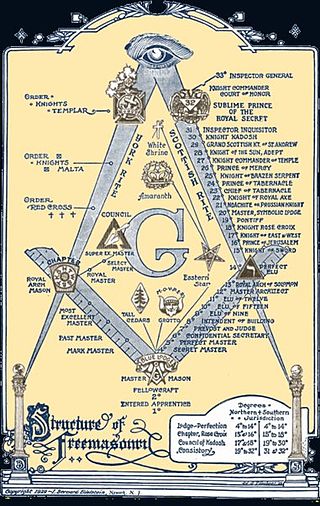
Freemasonry or Masonry refers to fraternal organisations that trace their origins to the local guilds of stonemasons that, from the end of the 13th century, regulated the qualifications of stonemasons and their interaction with authorities and clients. Modern Freemasonry broadly consists of two main recognition groups: Regular Freemasonry, which insists that a volume of scripture be open in a working lodge, that every member professes belief in a Supreme Being, that no women be admitted, and that the discussion of religion and politics do not take place within the lodge; and Continental Freemasonry, which consists of the jurisdictions that have removed some, or all, of these restrictions.

A Masonic lodge, often termed a private lodge or constituent lodge, is the basic organisational unit of Freemasonry. It is also commonly used as a term for a building in which such a unit meets. Every new lodge must be warranted or chartered by a Grand Lodge, but is subject to its direction only in enforcing the published constitution of the jurisdiction. By exception the three surviving lodges that formed the world's first known grand lodge in London have the unique privilege to operate as time immemorial, i.e., without such warrant; only one other lodge operates without a warrant – the Grand Stewards' Lodge in London, although it is not also entitled to the "time immemorial" title. A Freemason is generally entitled to visit any lodge in any jurisdiction in amity with his own. In some jurisdictions this privilege is restricted to Master Masons. He is first usually required to check, and certify, the regularity of the relationship of the Lodge – and be able to satisfy that Lodge of his regularity of membership. Freemasons gather together as a Lodge to work the three basic Degrees of Entered Apprentice, Fellowcraft, and Master Mason.

The Grand Lodge of the Republic of Liberia is a fraternal organization based on the principles of Prince Hall Freemasonry. Prior to 1980, its membership tended to consist of Americo-Liberians and it was influential within the ruling True Whig party from its founding until the coup of Samuel Doe in 1980, when much of its senior leadership was killed and the new military regime banned masonic activities in the country.

The George Washington Masonic National Memorial is a Masonic building and memorial located in Alexandria, Virginia, outside Washington, D.C. It is dedicated to the memory of George Washington, the first president of the United States and a Mason. The tower is fashioned after the ancient Lighthouse of Alexandria in Egypt. The 333-foot (101 m) tall memorial sits atop Shooter's Hill at 101 Callahan Drive. Construction began in 1922, the building was dedicated in 1932, and the interior finally completed in 1970. In July 2015, it was designated a National Historic Landmark for its architecture, and as one of the largest-scale private memorials to honor Washington.

Freemasons' Hall in London is the headquarters of the United Grand Lodge of England and the Supreme Grand Chapter of Royal Arch Masons of England, as well as being a meeting place for many Masonic Lodges in the London area. It is located in Great Queen Street between Holborn and Covent Garden and has been a Masonic meeting place since 1775.

There are many organisations and orders which form part of the widespread fraternity of Freemasonry, each having its own structure and terminology. Collectively these may be referred to as Masonic bodies, Masonic orders or appendant bodies of Freemasonry.
Christopher L. Hodapp is an American author and filmmaker, noted for his writings about Freemasonry, fraternalism, the Knights Templar, secret societies and conspiracy theories. He is the founding editor in chief of the Journal of The Masonic Society, the Associate Director of the Masonic Library and Museum of Indiana, and Public Relations Director for the Grand Lodge F&AM of Indiana.

The Grand Lodge of Free & Accepted Masons of Indiana is one of two statewide organizations that oversee Masonic lodges in the state of Indiana. It was established on January 13, 1818. The Grand Lodge of Indiana's offices and archives are located in the Indianapolis Masonic Temple.

Masonic ritual is the scripted words and actions that are spoken or performed during the degree work in a Masonic lodge. Masonic symbolism is that which is used to illustrate the principles which Freemasonry espouses. Masonic ritual has appeared in a number of contexts within literature including in "The Man Who Would Be King", by Rudyard Kipling, and War and Peace, by Leo Tolstoy.

Thomas Smith Webb was the author of Freemason’s Monitor or Illustrations of Masonry, a book which had a significant impact on the development of Masonic Ritual in America, and especially that of the York Rite. Webb has been called the "Founding Father of the York or American Rite" for his efforts to promote those Masonic bodies.

Muncie's Masonic Temple is a historic fraternal lodge building located in Muncie, Indiana. The building is now only used by the Cornerstone Center for the Arts. The Muncie Masonic Temple is in the Gothic Revival style, and was designed and built during the height of the City Beautiful Movement.
A Masonic Temple or Masonic Hall is, within Freemasonry, the room or edifice where a Masonic Lodge meets. Masonic Temple may also refer to an abstract spiritual goal and the conceptual ritualistic space of a meeting.

The Level Club is a residential building on the Upper West Side of Manhattan, New York City, located at 253 West 73rd Street. It was built as a men's club by a group of Freemasons in 1927; it served this original function for just about three years. Afterwards, the building was used, in turn, as a hotel and a drug re-hab center. It has now been remodeled as a condominium.

Victoria Masonic Temple in Colombo, Sri Lanka is the meeting place for the Masonic Lodges in the Colombo area. It was built in 1901 during British rule.

The New Masonic Temple is a historic building in St. Louis, Missouri, built in 1926. Like many other buildings built for Freemason meeting places, it shows Classical Revival architecture.

The Asheville Masonic Temple is a Masonic Temple located in Asheville, North Carolina. Designed by British American architect and Freemason Richard Sharp Smith, the building was opened in April 1915. It is listed in the United States National Register of Historic Places as a contributing building in the Downtown Asheville Historic District.

Mark Masons' Hall in London is the headquarters of The Grand Lodge of Mark Master Masons of England and Wales, which is also responsible for the Royal Ark Mariner degree. It is located in 86 St James's Street in the central London district of St James's, opposite St James's Palace. While Freemasons' Hall is the headquarters of the United Grand Lodge of England and the Supreme Grand Chapter of Royal Arch Masons of England, Mark Masons' Hall is the home of several other important appendant orders of Freemasonry in England and Wales.

The Grand Lodge Building is a historic building at the intersection of Broadway and 7th Avenue in Nashville, Tennessee, U.S. It houses the Grand Lodge of Tennessee of Free and Accepted Masons. In addition to offices, meeting spaces, and a dining hall, the building also contains a Masonic library, museum, a large theatrical auditorium and stage, and a collection of portraits of all the Past Grand Masters of Tennessee.























